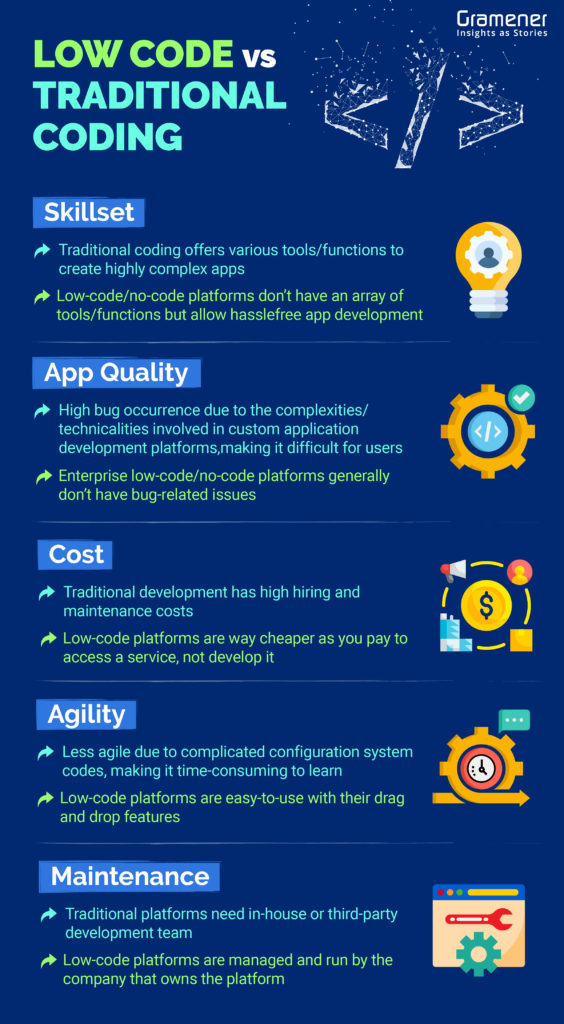Citizen development is a new-age, no-code method to software development. It has gained much prominence in recent years. Imagine a scenario where your core IT team is neck-deep in work with a long backlog. But your business needs some quick IT solutions. Enter citizen development.
Your developers can use cloud technology and automation tools to create solutions. As it does not involve complex coding, it might come across as a novel idea. But it is not new and has evolved in recent years. It is due to the benefits of the cloud and automation. We take an in-depth look at the concept of citizen development. We further explore its potential.
Table of Contents
What is Citizen Development?
Citizen development gives non-IT employees a platform to emerge as software developers. They can use low-code/no-code (LCNC) mediums to create solutions. It will help solve urgent issues. Developers can also create or customize existing applications that match the business needs. They can improve process efficiencies as well.
Despite no background in coding, your employees can become citizen developers. The applications have IT-approved technology. So, there is nothing to worry about their reliability. There is no need for your IT teams to get involved in the citizen development program. They can focus on their core duties and meet organizational objectives.
According to a survey, 80% of businesses accepted citizen development initiatives that have helped. Their IT teams have experienced a reduced work burden.
Businesses must understand that citizen development has the potential to redefine software development. According to Gartner, 61% of businesses have used or plan to engage citizen developers. They have understood that citizen development needs a look at as a long-term solution.
Getting approvals for each project can be a frustrating prospect. It is especially true when IT teams remain overloaded with work. By the time the acceptance comes, priorities might likely change. Citizen development thus presents an agile option. It can adapt to the ever-changing IT landscape.
2019 saw low-code development platforms markets generate $10.3 billion in revenue.
The projection is a CAGR of 31.1% during the 2020-2030 period. Some demand-driving factors are reducing dependency on IT professionals. Also, it includes increased needs for digitization.
A survey has made it clear that business initiatives do not slow down if a company focuses on IT. Instead, 12% of low-code users have got their application backlogs improved. There is no need for any formal training for low-code tools.
Several industries have realized the benefits offered by no-code platforms and citizen development. Here is a list of sectors where developers are using LCNC platforms to create solutions.
- Logistics
- Manufacturing
- Food and retail
- Pharma
- Insurance and finance
Why Should Enterprises Prefer Citizen Development?
The processes of IT teams can be challenging with complex workflows. It is especially the case with organizations that have large-scale operations. Internal coordination is critical, without which chances of slow down and delays increase. Here are some common problems faced by most IT teams.
- They have to create enterprise-wide solutions keeping in mind the need of users.
- Resources can often be expensive and limited.
- Communication issues halt the work progress leading to delays.
Citizen development initiatives can be a step in the right direction. Here are several benefits that businesses can enjoy.
Staff Shortage Issues
IT is the second biggest domain that needs to take care of the potential skill gaps. When there is a shortage of skilled employees, businesses have to pay more to attract the best talent. The best talent indeed comes at a premium. But this might not be a sustainable solution for organizations with lean budgets. Citizen developers cannot replace regular developers. But the cost of hiring them will be lesser. Citizen development can thus help in cutting down costs and improve profit margin.
Development Pace
You would already know how complex and tedious traditional coding is. With the advancements in technology, there is a need to do bring in innovative solutions. LCNC platforms cut the need for complex coding. A low code citizen developer can design applications in simple ways and at a much faster rate.
Smooth Internal Functioning
The synergy between teams, irrespective of the level they work at, is critical. Issues between IT teams and management can be a source of the problem. It is true when there is no common understanding of applications and frameworks. As LCNC platforms do not need complex frameworks, developers can work well with everyone. The scope of miscommunication also gets reduced with the citizen development initiatives.
Digital Transformation
Digitally mature companies enjoy a range of benefits. It includes improved productivity and customer satisfaction. The pandemic has provided the impetus for businesses ignorant of the digital-first approach. If you want to bring a digital transformation, promoting innovation is essential. Citizen development can help democratize app development and build an innovation-led culture.
Citizen Developers Vs. Professional Developers
Citizen developers are business users who can create no-code applications. They do not need prior knowledge related to the development of applications. LCNC platforms are their savior. A low code citizen developer can make applications without any worries.
This differentiation between low code and traditional development will help you explore and decide which technology suits best to your business.
Professional developers use high code or traditional code. These are the two variants of pro code. The difference between no, pro, or low code boils down to the level of coding needed. No-code applications have a Graphical User Interface (GUI). It helps developers build code-free solutions. Developers that use pro codes cannot function like citizen developers.
Here is a list of various developers based on the above explanation.
- Citizen developer are users who use no-code development platforms
- Pro citizen developer are users who use low-code platforms
- Regular developers who use low or pro code to meet business requirements
- Regular developers who use pro code to upgrade existing applications
The benefits of citizen development are immense. It is likely that the number of developers using that platform will rise in the coming years.
Citizen Development Low-code Platforms to Build Apps
The development life-cycle of low-code platforms is different from regular ones. The approach is different, and so are the capabilities. Some users might want to support the entire development life-cycle on the platforms. Others may focus on speed. Many users also take an integrated approach where regular and citizen developers can collaborate and work in unison. Low-code platforms have better integration capabilities. They also offer hosting options and DevOps tools.
Here are different citizen development tools that can help you build applications.
Gramex
GRAMEX™ is a low-code PaaS (platform-as-a-service) data platform that helps in the swift creation of engaging data and analytics solutions. The platform has more than a thousand purpose-built data applications and embeds 90% of common elements. You can create enterprise-grade data science applications in less than 24 hours. With a single click, you can assemble all microservices from 200+ pre-built components built on Python and Javascript.
Outsystems
They have specialized tools that meet the varied requirements of the project teams. The development steps also remain tied to each other with a platform layer. With seamless integration, the tool allows users to use custom codes based on their needs. So, there is no reason for developers to switch back to the traditional ways of developing applications. It is one of the best software for citizen developers.
Caspio
You can expect support and help on the platform from the service provider. It includes the app versioning and real-time preview. There is a possibility of creating customized applications with the help of SQL and JavaScript. You can also use the citizen development platform’s REST API or a third-party tool like Zapier.
Appian
This citizen development platform comes with native deployment tools. They offer good integration capabilities. For example, it can integrate with Jenkins, which is a DevOps tool. Developers can also use integration tools to extend the platform with Java-based plugins.
Mendix Cloud
The platform supports the entire software development life-cycle. It includes testing, deployment, version control, and others. With the help of integration tools like Jenkins or Jira, developers can make full use of them. Developers can deploy the application to Mendix Cloud, Azure, and similar platforms. Furthermore, they can couple it with container technologies. These include the likes of Kubernetes, Cloud Foundry, etc.
Boomi Flow
It is possible to get an open architectural stack with wide integration connectors. This citizen development platform has a REST APIs base. The automatic versioning and debugger are a few highlights that make it worthy. You can use the platform for various development life-cycle needs. It includes development, testing, and much more. Developers also have the option of integrating other source code systems like Jenkins and Git.
VisionX
This low-code, Java-based platform can also work with the Eclipse IDE. It offers support for bidirectional code generation. The platform architecture makes it easy for developers to use any version control. Furthermore, they can also test automation platforms. It is possible to deploy applications with the help of CI/CD tools or Jenkins. You can then run them in application servers like Tomcat.
Quick Base
This platform offers the capabilities of an integrated stack. You can auto-generate and host applications. Developers can test and extend functionalities, use automation capacities, drag-and-drop integration, etc.
The Bottomline
Using means to improve the internal teams’ productivity and customer satisfaction is crucial. In that sense, taking the help of the right technology is essential. Citizen development can bring a paradigm shift to the way you create applications. Like adopting any other technology solution, you need to define objectives before starting. Create guidelines and establish citizen development governance. Additionally, improve collaboration with the core IT team. It will boost the confidence of your citizen developers and make them perform better.
More Resources
- Find out how Open Source Low Code technology is helping Citizen Developers build data and AI Apps.
- Check out some Machine Learning apps built on low-code.
- How low-code platform is helping enterprises build analytics apps faster.


